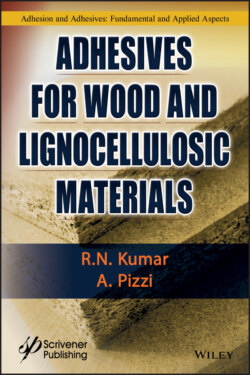Читать книгу Adhesives for Wood and Lignocellulosic Materials - R. N. Kumar - Страница 16
1.3.1 Physical Structure
ОглавлениеThere are two major types of wood: softwood (from needle-bearing trees) and hardwood (from broad-leaved trees). The terms softwood and hardwood are misnomers and have little to do with hardness or density. Many softwoods are actually much harder than many hardwoods [5].
In both softwoods and hardwoods, the most noticeable features are the light outer ring and the dark inner core. Thus, the wood in the trunk of the tree is typically divided into two zones, each of which serves an important function distinct from the other. The actively conducting portion of the stem in which parenchyma cells (explained later) are still alive and metabolically active is referred to as sapwood [6].
A looser, more broadly applied definition is that sapwood is the band of lighter-colored wood adjacent to the bark. Heartwood is the darker-colored wood found to the interior of the sapwood. As the tree grows larger in diameter, cells closer to the center of the tree, which are no longer required for these activities, die and are converted to heartwood.
In the living tree, sapwood is responsible not only for conducting sap but also for storage and synthesis of biochemicals. An important storage function is the long-term storage of photosynthesis products. The primary storage products of photosynthates are starch and lipids. Living cells of the sapwood are also the agents of heartwood formation. Biochemicals must be actively synthesized and translocated by living cells [6]. For this reason, living cells at the border between heartwood and sapwood are responsible for the formation and deposition of heartwood chemicals, one important step leading to heartwood formation [7].
These chemicals are collectively named as extractives and are known for protecting the wood. Extractives also play a significant role in the adhesive bonding of wood. Extractives are formed by parenchyma cells at the heartwood–sapwood boundary and are then exuded through pits into adjacent cells [7]. In this way, dead cells can become occluded or infiltrated with extractives despite the fact that these cells lack the ability to synthesize or accumulate these compounds on their own. When these chemicals oxidize, the heartwood darkens, and the border between sapwood and heartwood becomes more distinct. Heartwood formation differs markedly between species, even within trees of the same species. These changes, especially the chemical changes, account for much of the difficulty and unpredictability in the bonding of heartwood [5].
